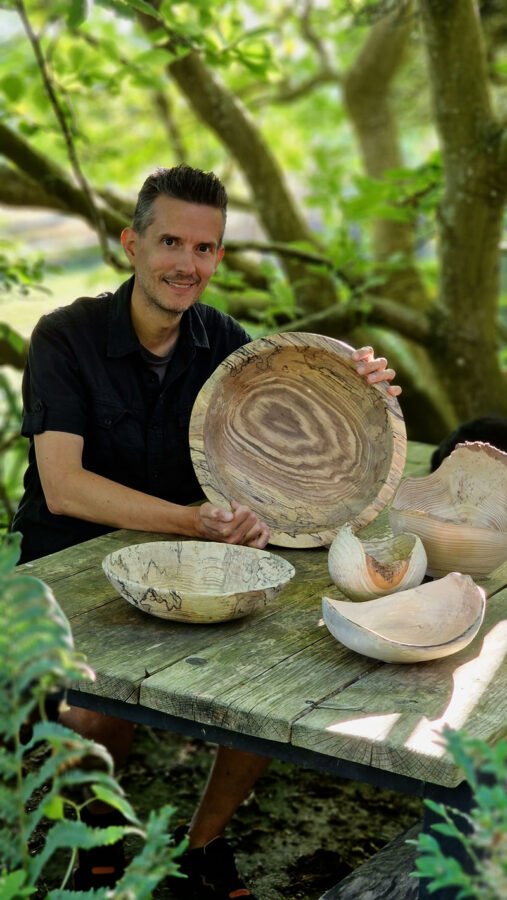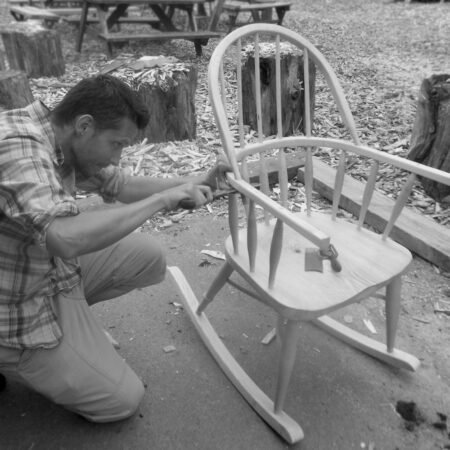My Journey Here
I’ve been creative all my life — drawing as a child, making music as a teenager, then working in web and graphic design as an adult.
I first began turning wood in 2009, starting with bowls on a power lathe before discovering the quiet rhythm of a pole lathe. I was drawn to the simplicity of green woodworking — using freshly cut wood to make chairs, benches and stools. That way of working suited me: intuitive, quiet, physical. But eventually, illness and injury meant I could no longer use the pole lathe.
The last few years have brought a series of life-altering health challenges:
First came post-Covid syndrome (long Covid), which forced me to leave my job. Then, a stroke — caused by an undiagnosed hole in my heart — temporarily took my sight. While recovering from both, I severely injured my knee and later underwent a procedure to repair the heart defect.
At first when I suffered the stroke, I lost my vision completely and for a while I didn’t know what the long term effects would be. And I was still living with the exhaustion of long Covid.
It’s been difficult. But it is what it is, and it has brought me to where I am now.
Today, I’m grateful for my recovery, for my sight, and for the chance to keep creating with wood — the craft that brings me peace and purpose.
Now
These changes have reshaped my path. After being advised to stop using a pole lathe, I returned to a power lathe — a new tool for a new chapter. I’ve since come full circle, back to turning bowls, and into exploring forms, shapes, and textures. I’ve begun creating vessels that are more sculptural than functional — pieces that speak of the wood’s character and movement.
Going forward, I have many ideas I want to try. I’ll be experimenting with techniques, tools, and materials — shaping new forms that explore contrast, tactility, and the quiet beauty of wood.

My Style
When I came across the Japanese concept of Wabi-sabi, something clicked. It gave a name to what I was already feeling — a way to describe my approach to making, and to life.
Wabi-sabi embraces the imperfect, the impermanent, the incomplete. It finds beauty in asymmetry, in the worn, in the weathered. Wood is never perfect — and I don’t want it to be.
Each piece I make carries quiet truths:
a gentle warp in the rim, a ripple in the grain, a hairline crack where the tree once held tension.
The irregularities, and the imperfections are not things to fix – they are things to celebrate.
Handcrafted.
Unique.
Organic.
Not sterile, impersonal, or mass produced.
Why Wood?
There’s something deeply human — maybe even ancestral — about our relationship with wood. It’s tactile. Grounded. Alive. You want to touch it, run your hand over the grain, feel its warmth and texture.
Wood is also a natural, renewable resource. When grown, felled or coppiced responsibly, it’s one of the most sustainable materials we can use — and one of the most beautiful.
Each species is different. Each tree grows with its own story — shaped by light, soil, weather, and time. No two pieces of wood are the same, and every one brings its own challenges and gifts.
My Ethos
Nature, animals and wildlife have always been at the heart of who I am. They’re not just things I love — they’re where I find meaning, connection, and calm.
I care deeply about the environment. Loving wood means respecting the trees it comes from, and the wider ecosystems they’re part of. That care guides every decision I make in my process — from materials and finishes to the tools and techniques I use.
I look at three things:
1. Origin –
Where things come from: the source of the wood, and the ingredients in the oils and finishes I apply.
2. Process –
How I make: Not using epoxy resins and petrochemical-based tools like blowtorches. I don’t want to introduce toxins or microplastics into the world while making something meant to honour nature.
3. Longevity & Impact –
What happens after a piece leaves my hands: every item is made using non-toxic, natural materials that are safe for your home and body. And if one day the piece is no longer wanted, it will break down without harming the environment.

